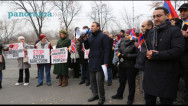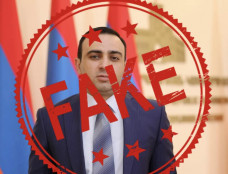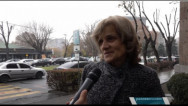
Euronews: NKR army stands ready at any time to face offensive by Azerbaijani forces
Another edition of the Euronews TV channel’s program Insiders is dedicated to the situation in the Nagorno-Karabakh Republic. Reporter Valerie Gauriat prepared a reportage based on her trip to the region, as well as the numerous interviews she conducted there.
Reportedly, Karabakh is mainly populated by ethnic Armenians. The Karabakh conflict has been frozen for more than 20 years. A heavy fighting broke out in April. The calm restored since is fragile.
Reporter Valerie Gauriat visited NKR, where she met with soldiers. According to her, many are barely 20 years old. Some had experienced war for the first time in spring, when the heaviest fighting broke out in the Nagorno-Karabakh Republic since 1994.
“We’re defending our homeland, our family, and all those who live on this land,” soldier Aram Yegoryan said in an interview with the reporter.
Fighting dates back to 1988, when Karabakh, populated mostly by Armenians, proclaimed its independence from Azerbaijan. A ceasefire was reached in 1994 after the Armenian military victory. It is highlighted that despite ceasefire, soldiers stand guard day and night.
Supported in April by many volunteers from Armenia, Nagorno-Karabakh’s army says it stands ready at any time to face an offensive by Azerbaijani forces.
“Since the ceasefire in 1994, the opposition has always violated the truce. They were the ones who started it last April. There’s no reason why they wouldn’t do it again. We’re better prepared now, and if it happens, we will resist it very strongly,” said Sevak Sardaryan, Chief of Artillery on the northern front.
Close to the frontline is the Armenian village of Talish, a symbol of the 1990’s war. Last spring it was entirely destroyed again. All the inhabitants were evacuated. The journalists were told that three civilians who refused to leave the village were killed during the offensive.
One of the displaced residents, Garik Ohanyan, returned to the scene to show the journalists what was left of his house. “This is my home. I suffered for 20 years to build my house – 20 years! Nine people used to live here, nine of us!” he said.
Garik found refuge in a neighboring village, at his in-laws, where he now lives with his mother, his wife, and their five children. Living conditions are difficult, but they are afraid to go back to their village.
“My other son died in the first war, I get a pension for that. I only have one son left, who has five children. What are we going to do now?” said Garik’s mother Amalya Ohanyan.
Garik Ohanyan added that since they first fled the village, back in 1992, and up until today, they expected the war to start again. Now all they want is a peaceful solution.
Valerie Gauriat also met NKR foreign affairs minister, Karen Mirzoyan. “We believe that we have to return Nagorno-Karabakh to the negotiation table. Twice, in 1991 and in 2006, the people of Nagorno-Karabakh voted for the independence of this Republic. The decision of the people of Nagorno-Karabakh, the result of their vote, have to be taken into account and become a cornerstone of any further settlement,” Mirzoyan noted.
The recognition of Nagorno-Karabakh as a state is also what Karen Matevosyan and his family have longed for. Karen settled here in Stepanakert after he, his wife and their young son fled the pogrom targeting Azerbaijan’s Armenians in 1988, in the town of Sumgait.
“It was really horrible. They burned people alive, they raped women, even children. I would not wish what we went through during those three days in Sumgait on anyone, even my worst enemy,” K. Matevosyan said.
Karen and his wife can no longer imagine leaving Karabakh, the land of their ancestors, and now theirs. The war in April revived painful memories when they saw their son leave for the front line. “The only good decision to take is for Azerbaijan to recognize our independence,” he added.
It is also noted in the reportage that the TUMO center in Stepanakert aims to give Nagorno-Karabakh’s teenagers a window on the world. After school, free workshops equipped with high tech tools help introduce them to creative technology.
Samvel Sargsyan, a student at the center, lost his uncle in the conflict. A loss that inspired his first project: a photo exhibition dedicated to the everyday life of Armenian soldiers on the front line.
“I wanted the public to see our strength by looking at these photos, our spirit. And to see that these men are always ready. I wanted to show the positive aspects, not the negative ones. I’ve seen the bad side of things, but I chose to show the good sides,” Sargsyan said.
Related news
Newsfeed
Videos






























